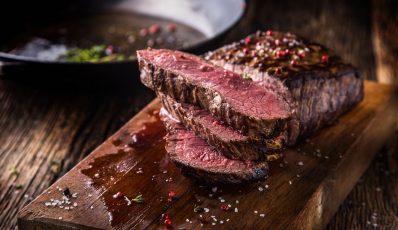Meat is an integral part of many diets, valued both for its taste and richness of nutrients. However, in the face of the abundance of information and dietary trends, we often ask ourselves: What meat is the healthiest? Should we limit red meat in favor of white meat, or pay attention to where and how our meat choices are processed? In this article we will try to dispel these doubts, providing information and practical advice that will help you make an informed choice of meat.

Meat is an integral part of many diets, valued both for its taste and richness of nutrients. However, in the face of the abundance of information and dietary trends, we often ask ourselves: What meat is the healthiest? Should we limit red meat in favor of white meat, or pay attention to where and how our meat choices are processed? In this article we will try to dispel these doubts, providing information and practical advice that will help you make an informed choice of meat.
What does “healthy meat” mean?
Defining what exactly the term “healthy meat” means can be key to understanding how different types of meat affect our health. Healthy meat is one that provides us with high-value proteins, vitamins, and minerals while minimizing the negative impact on the health of ingredients such as saturated fats or food additives such as preservatives or flavor enhancers.
First of all, healthy meat should come from responsible sources, where animals are bred in good conditions, fed with natural feed, and free from excessive amounts of antibiotics and growth hormones. This affects not only the quality of the meat but also the overall ethics of food production.
Moreover, the meat processing process has a significant impact on its health properties. Meat cooked using healthier methods that require less fat, such as roasting, grilling, steaming, or sous-vide, usually contains less saturated fat and calories, which is better for your heart and overall health.
Nutritional values of meat
Meat is not only a source of protein but also provides a number of other important nutrients. So we can choose the type of meat on our plate according to Its health benefits and dietary uses:
Poultry
Poultry meat, especially chicken and turkey, is one of the most popular choices in the world due to its beneficial health properties and culinary versatility. It is characterized by a high protein content with a relatively low-fat content, which makes it an excellent choice for people who care about their figure and health.
Nutritional values
- Protein: Poultry meat is rich in protein, which is necessary for building muscles and the proper functioning of the body. For example, 100 grams of lean chicken breast provides approximately 31 grams of protein.
- Fat: Lean cuts such as breast contain minimal amounts of fat, approximately 3.6 grams per 100 grams, a small portion of which is saturated fat.
- Vitamins and minerals: Poultry meat is an excellent source of B vitamins, including niacin (B3), which is crucial for maintaining skin health and nervous functions, and pyridoxine (vit. B6), which supports energy metabolism and the formation of red blood cells.
Health benefits
- Cardiovascular support: The low saturated fat and cholesterol content of poultry contributes to better heart health.
- Support for muscle mass: High protein content supports the construction and regeneration of muscle tissue, which is especially important in the diets of athletes and physically active people.
- Metabolic support: B vitamins play a key role in maintaining a healthy metabolism, supporting the conversion of proteins, fats, and carbohydrates into energy.
-
Sous-Vide Cooker – 700 W – 30 – 95 ° C – 24 L – LCD
469.00 €429.00 € -
Multicooker – 5 Litres – 16 Programmes
-
Contact Grill – smooth – 2,200 W 179.00 €
-
Tower Rotisserie – 3-in-1 – 1.800 W – 31 L
139.00 €129.00 €
Red meat
Red meat, which includes beef, lamb, and pork, has long been a staple diet in many cultures. Rich in key nutrients, red meat is also the subject of debate about its health effects.
Nutritional values
- Protein: Red meat is an excellent source of complete protein, essential for proper development and tissue repair. For example, 100 grams of lean beef provides approximately 26 grams of protein.
- Iron: One of the greatest benefits of red meat is its high content of easily digestible iron, which is crucial in preventing anemia.
- Vitamin B12: Red meat is one of the best sources of vitamin B12, which plays an important role in the production of red blood cells and the functioning of the nervous system.
- Zinc: Essential for the immune system and wound healing process.
Health benefits
- Support for blood cell production: Due to its high content of easily digestible iron and vitamin B12, red meat may contribute to blood health and prevent anemia.
- Support for growth and recovery: Protein-rich red meat helps build muscle mass.
- Immunity Boost: Zinc present in red meat supports the immune system, helping to protect the body against disease.
Risks
- Cardiovascular disease and other conditions: Frequently eating large amounts of red meat, especially processed meat, may be associated with an increased risk of heart disease, type 2 diabetes, and some types of cancer.
- Saturated fat and cholesterol: Red meat also contains saturated fat and cholesterol, which in excess can contribute to heart disease.
Fish and seafood
Fish and seafood are considered a key element of a healthy diet due to the content of high-quality protein and other valuable nutrients, including essential omega-3 fatty acids.
Nutritional values
- Protein: Fish provide complete protein that is easily digestible. For example, 100 grams of salmon contains about 25 grams of protein.
- Omega-3: Fatty fish such as salmon, mackerel, and sardines are exceptionally rich in omega-3 fatty acids, which are known to benefit heart, brain, and joint health.
- Vitamins and minerals: Fish are an excellent source of fat-soluble vitamins such as vitamin D and B12, as well as minerals such as selenium, iodine, and zinc.
Health benefits
- Heart health: Regular consumption of fish helps to lower triglyceride levels and improve the overall elasticity of blood vessels, reducing the risk of cardiovascular disease.
- Support for brain function: Omega-3s are crucial for brain health, supporting cognitive function and reducing the risk of neurodegenerative disorders.
- Support for joint health: Omega-3 fatty acids may also help reduce inflammation, which is beneficial for joint diseases such as rheumatoid arthritis.
Potential risk
- Heavy metals and pollutants : Some fish can accumulate heavy metals such as mercury, which poses a risk especially to children and pregnant women.
Wild game meat
Game meat, including species such as deer, wild boar, roe deer, and hare, is gaining popularity as a healthier alternative to red meat. Game meat is exceptionally lean, low in saturated fat, and rich in nutrients, making it appreciated for both its taste and health benefits.
Nutritional values
- Protein: Game meat is an excellent source of protein that is particularly lean and free of excess fat. For example, 100 grams of deer meat provides about 30 grams of protein.
- Iron: Game meat is also a valuable source of iron, which is easily absorbed and supports blood health.
- Zinc: Game also provides zinc, crucial for the immune system and metabolism.
- B vitamins: Rich in vitamins such as B12 and B6, which are necessary for the functioning of the nervous system and energy metabolism.
Health benefits
- Cardiovascular support: The low levels of saturated fat and cholesterol in game meat contribute to an improved blood lipid profile, which may reduce the risk of heart disease.
- Increased satiety with lower calorie content: The high protein content contributes to a better feeling of satiety, which is beneficial in reducing diets.
- Support for blood health: Iron in an easily absorbable form helps prevent anemia, which is especially important for people with iron deficiency.
Potential risks
- Availability and freshness: Game meat may be more difficult to purchase in some regions, and its quality depends greatly on the conditions in which the animals lived and were slaughtered.
- Contamination: There is a risk of parasites or bacteria being present in wild game, especially if the meat has not been properly processed.
What meat to avoid?
When composing a healthy diet, it is worth paying attention to types of meat that may have a less beneficial effect on our health. It is especially recommended to limit the consumption of processed meats, such as sausages, cold cuts, bacon, and salami . These products often contain high amounts of saturated fat, salt, and chemical additives, including preservatives such as nitrites and nitrates, which may increase the risk of developing cardiovascular disease and some types of cancer, especially colorectal cancer.
Additionally, it is worth avoiding excessive consumption of red meat, which may increase the risk of certain diseases, including cancer and heart disease. Instead, a more balanced approach to the diet is recommended, with meat as one of many sources of protein.
When choosing meat, it is best to choose products from reliable sources, preferring those from organic farming or certified farms. This helps avoid potential harmful health effects associated with industrial meat processing.
Meat in the diet – questions and answers
Is meat necessary in a healthy diet?
Meat is a valuable source of protein, B vitamins, iron, and other nutrients, but it is not necessary to maintain health. Plant-based or vegetarian diets can provide similar benefits if properly balanced and supplemented with alternative sources of these nutrients.
What fish are the healthiest to eat?
Oily fish such as salmon, mackerel, and sardines are considered the healthiest due to their high content of omega-3 fatty acids. It is important to choose fish from wild, sustainable fisheries or responsible farms.
How often should you eat meat?
The frequency of meat consumption and recommended portions may vary depending on individual health needs, dietary preferences, and the type of meat. Below are indicative guidelines for eating different types of meat during the week:
- Poultry: It is recommended to eat poultry, such as chicken or turkey, 2-3 times a week. Portions should weigh approximately 100-150 grams per meal.
- Red meat (beef, lamb, pork): Due to the possible risks associated with eating large amounts of red meat, it is recommended to limit its consumption to approximately 1-2 times a week, with portions not exceeding 100 grams per meal.
- Fish: It is recommended to eat fish, especially fatty fish rich in omega-3 acids, such as salmon, sardines, or mackerel, 2-3 times a week. Portions can be slightly larger, around 150-200 grams per meal.
- Game meat: Due to its low fat and high protein content, game meat can be eaten 1-2 times a week, with portions of 100-150 grams per meal.
It is important to remember to diversify your protein sources, including plant-based meat substitutes in your diet, which may offer additional health benefits and reduce the risks associated with eating large amounts of meat.






Share